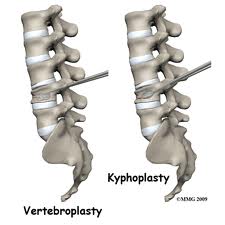These two orthopedic spinal reconstruction pocedures have become popular in the past few years. “Vertebroplasty” means doing a repair job on a damaged vertebral bone (spinal column bone). Originally this was developed for end stage cancer patients who had a single bone metastasis that led to a collapse of this vertebral bone. The difference in a good outcome of this procedure can mean the difference between being bedridden until death or walking and being active.
In a recent review of THE BACK LETTER (Vol.12, 12, Dec. 2002, Lippincott Williams & Wilkins), which critically reviews the literature regarding back pain and treatments, this procedure, even if successful, has not been researched long enough to be considered “standard therapy”. Many investigators report a success rate of 95% for compression fractures in patients with osteoporosis. But the FDA has warned that the bone cement that it used in this type of spinal surgery has never been properly investigaed for this application in non-cancer patients.
Nevertheless the technique of vertebroplasty has been clinically so impressive that those with severe kyphosis in the spine also wanted surgery. Kyphosis is a roundback in the mid spine area (thoracic spine) that can significantly interfere with normal posture, breathing action and cardiovascular functioning. Kyphoplasty is the procedure of repairing the curvature of the kyphosis, which consists usually of a series of several vertebral bodies with wedge shaped compression fractures in the thoracic spine. Often these patients are older and have osteoporosis.
THE BACK LETTER warns that the verdict on longterm follow-ups is not out. It may take a long time, even 10 to 15 years before this will become available as proper controlled studies have never been done. As the FDA link show, there can be serious life threatening complications from the procedure itself (spinal cord compression, respiratory arrest and death etc.). However, the longterm complications have not been reported properly as there is no longterm trial going on where the investigators would specifically concentrate on finding complications and untoward side-effects.
A well-designed multicenter trial regarding vertebroplasty and kyphoplasty is badly needed to answer these safety questions. Apparently efforts are on their way to attempt to do this.
Here is a link to my nethealthbook.com chapter on osteoporosis:
http://www.nethealthbook.com/articles/rheumatologicaldisease_osteoporosis.php
Last edited December 10, 2012






